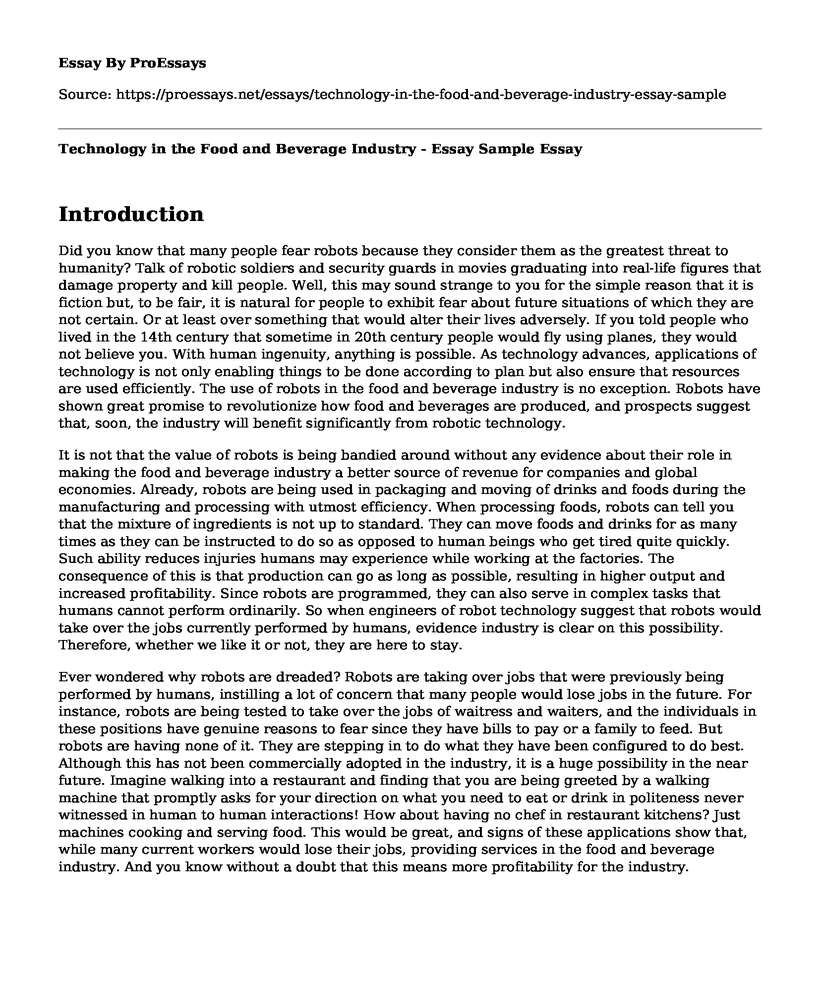Introduction
Did you know that many people fear robots because they consider them as the greatest threat to humanity? Talk of robotic soldiers and security guards in movies graduating into real-life figures that damage property and kill people. Well, this may sound strange to you for the simple reason that it is fiction but, to be fair, it is natural for people to exhibit fear about future situations of which they are not certain. Or at least over something that would alter their lives adversely. If you told people who lived in the 14th century that sometime in 20th century people would fly using planes, they would not believe you. With human ingenuity, anything is possible. As technology advances, applications of technology is not only enabling things to be done according to plan but also ensure that resources are used efficiently. The use of robots in the food and beverage industry is no exception. Robots have shown great promise to revolutionize how food and beverages are produced, and prospects suggest that, soon, the industry will benefit significantly from robotic technology.
It is not that the value of robots is being bandied around without any evidence about their role in making the food and beverage industry a better source of revenue for companies and global economies. Already, robots are being used in packaging and moving of drinks and foods during the manufacturing and processing with utmost efficiency. When processing foods, robots can tell you that the mixture of ingredients is not up to standard. They can move foods and drinks for as many times as they can be instructed to do so as opposed to human beings who get tired quite quickly. Such ability reduces injuries humans may experience while working at the factories. The consequence of this is that production can go as long as possible, resulting in higher output and increased profitability. Since robots are programmed, they can also serve in complex tasks that humans cannot perform ordinarily. So when engineers of robot technology suggest that robots would take over the jobs currently performed by humans, evidence industry is clear on this possibility. Therefore, whether we like it or not, they are here to stay.
Ever wondered why robots are dreaded? Robots are taking over jobs that were previously being performed by humans, instilling a lot of concern that many people would lose jobs in the future. For instance, robots are being tested to take over the jobs of waitress and waiters, and the individuals in these positions have genuine reasons to fear since they have bills to pay or a family to feed. But robots are having none of it. They are stepping in to do what they have been configured to do best. Although this has not been commercially adopted in the industry, it is a huge possibility in the near future. Imagine walking into a restaurant and finding that you are being greeted by a walking machine that promptly asks for your direction on what you need to eat or drink in politeness never witnessed in human to human interactions! How about having no chef in restaurant kitchens? Just machines cooking and serving food. This would be great, and signs of these applications show that, while many current workers would lose their jobs, providing services in the food and beverage industry. And you know without a doubt that this means more profitability for the industry.
Cite this page
Technology in the Food and Beverage Industry - Essay Sample. (2022, Dec 14). Retrieved from https://proessays.net/essays/technology-in-the-food-and-beverage-industry-essay-sample
If you are the original author of this essay and no longer wish to have it published on the ProEssays website, please click below to request its removal:
- Current Energy Needs and Environmental Risks in Fossil Fuels Essay
- Sex Robots and Artificial Intelligence - Essay Sample
- NVIDIA: AI, GPUs, & the Race Against AMD - Essay Sample
- Essay on AI for Marketers: Unlocking New Market Fundamentals & Predicting Fluctuations
- Essay Example on Vegetarianism and Veganism: Different Ways to Live Animal-Product-Free
- Essay Example on Rising Cost of Healthcare: The Need for Innovative Solutions
- Project Management in Energy Industry: Streamlining Departments - Free Essay Example







